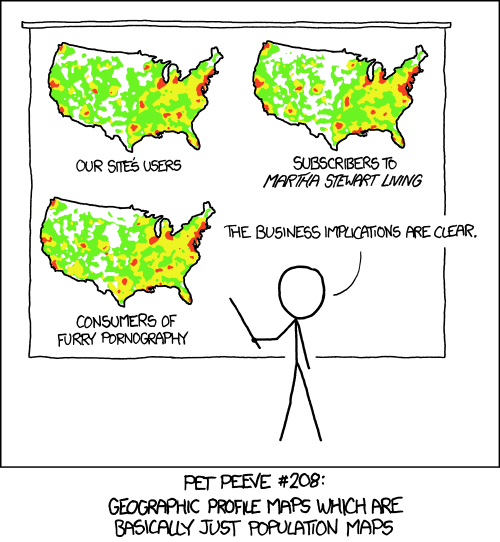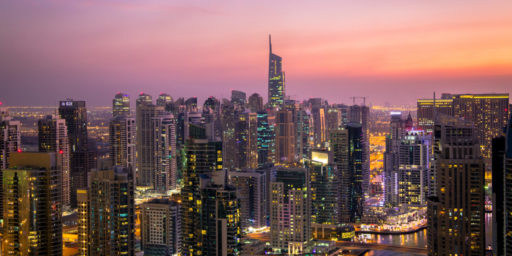US Economic Activity Map
This graphic from February is making the rounds this morning:
It was the Pew Research Center‘s Chart of the Week (“How metro areas drive the U.S. economy“) eight months ago. Their explanation:
It probably should come as no surprise that most U.S. economic activity is concentrated in metropolitan areas. What may be surprising, and what the map above shows so clearly, is just how concentrated in a handful of big metros the U.S. economy is.
Reddit user Alexandr Trubetskoy based this map on metro-area GDP estimates by consulting firm IHS Global Insight (in a report prepared for the U.S. Conference of Mayors). Six metro areas — New York, Los Angeles, Chicago, Washington D.C., Dallas and Houston — account for almost a quarter of the nation’s $16.8 trillion economy; add in the next 17 highest-ranked metros, and you account for about half of all economic activity.
This is a revision of Trubetskoy’s original map, which showed a rather stark 50-50 GDP split but, he said, had some methodological and mapping issues. But no matter how you slice the data, U.S. metropolitan areas are economic powerhouses. In the report referred to above, IHS noted that the combined GDP of the nation’s 10 largest metros exceeds the combined output of 36 states; the New York metro area alone produced more than all of Spain.
At first glance, it’s rather shocking. Essentially, almost all of the geographic area of the United States produces as much wealth as a tiny handful of metropolitan areas. Actually, though, that’s not surprising, because the vast number of people live in a tiny handful of metropolitan areas. It’s a classic example of the phenomenon Randall Munroe illustrates here:








But, but…that’s where all the welfare “takers” live!?!?
According to this map, white people are the least productive members of our society.
In the Portland, OR area the yellow area is all the result of Intel.
Speaking of the economy…
Q3 GDP was revised strongly upward as was Q2.
Watch the Dow close over 180,000 today.
Big increases in consumer spending…we’re seeing demand come back in spite of Reublican efforts to stop it.
http://www.bea.gov/newsreleases/national/gdp/gdpnewsrelease.htm
@C. Clavin:
if only we didn’t have austerity. Then the economy would be growing at 25%! Or something.
@Hal_10000:
Or it would have recovered far faster. Or something.
While I’m sure an accurate chart would still show GDP creation heavily biased toward urban areas, this data source for this map is a report on GDP production in metro area, so its present form is a tautology: all metro area GDP occurs in metro areas.
Furthermore, this is kind of the reverse illusion of those “red/blue” county maps they see after election. The important figure is not the total GDP produced by each particular area, but the per capita GDP.
@Hal_10000:
Obamacare is really holding back healthcare growth as predicted, as well.
See: Jane Jacobs, Cities and the Wealth of Nations.
Washington, DC is an interesting case. Since spent tax dollars out of the national capital could be viewed as having been siphoned off from the rest of the nation. It could be only a few metro areas are able to significantly produce more, and thus retain for local measurement, than is taken by the national capital?
That could explain the geographic divide between the higher and lower tax proponents?
It looks like Stormy is right.
So areas where there are a lot of people engaging in economic activity have a high level of economic activity.
It’s…whatever the exact opposite of “amazing” is.
@JKB: Yes, because we all live in The Hunger Games.
“Clearly if heavily Republican states are mired in poverty and debt and heavily Democratic states are thriving with the vast majority of productivity, it must be because liberals are oppressing Real Americans!”
Or maybe it’s just that everything you believe is wrong.
@Stormy Dragon: He took a list of GDP per metro area for the top 110 metro areas. But his base was total GDP for the country, not the total of the 110, which is about 75% of total GDP. (More accurately the top 104 = 75%, 110 = 75.8%.) In his map the remaining 25% is applied over the whole country.
So no, this is not just production in metro areas, and is not tautological.
A more useful critique would be where ag and resource extraction are credited: at the field or well, at a terminal, at a headquarters? I’m not curious enough to dig back to the sources. It’s unlikely to change the overall conclusion, that most value added occurs in and near cities.
I saw a global 3D of version of this years ago with GDP per square mile or hectare or some such plotted as altitude. It was offered as a corrective to Thomas Friedman’s The World is Flat. In this plot almost all of the world was quite flat. Sea level flat. But pretty much everything that happened, happened in the few big vertical spikes.
@gVOR08:
Yes, but only 15% of the population in this country lives outside metro areas. If that 15% is responsible for 25% of GDP, that paints a very different picture than this map does, again since it’s looking only at total GDP rather than GDP per capita.
@Stormy Dragon: Outside metro areas, major metro areas, or the 110 listed?
What point are you trying to make?
So, judging by this map, the Dallas-Ft. Worth metro has more output than the SF Bay Area, or Greater Philadelphia? Interesting. I definitely would not have guessed that.